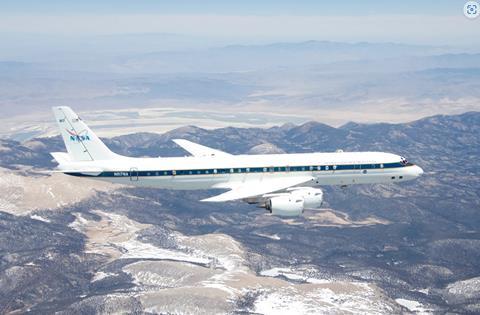American aerospace agency NASA is preparing to retire its unique flying laboratory after 37 years of service.
The aircraft, which NASA describes as the “largest flying science laboratory in the world”, is a specially modified McDonnell Douglas DC-8-72 passenger jet. NASA acquired the four-engined aircraft in 1985 and placed it into service as an airborne science laboratory in 1987.
Now, NASA says its unique DC-8 has flown its last mission.
The agency, which supports a wide range of scientific endeavours, said on 9 April that the DC-8 landed at the Armstrong Flight Research Center in Palmdale, California after completing an air quality survey flight on 1 April.
NASA says the aircraft will be formally retired in May.

After concluding active service, NASA’s DC-8 will be turned over to Idaho State University, where it will be used to train new aircraft maintenance technicians.
Over its service life, NASA says, the airborne science jet supported studies in archaeology, ecology, geography, hydrology, meteorology, oceanography, volcanology, atmospheric chemistry, cryospheric science, soil science and biology.
In addition to observations of the Earth’s surface and atmosphere, the DC-8 was tasked with sensor-development flights, satellite-sensor verification and supporting the launch and re-entry of space vehicles, including optical tracking and telemetry data collection.
“Because it is flown in the Earth’s atmosphere, the DC-8 offers a comparatively inexpensive way to test and verify prototype satellite instruments,” NASA’s airborne science programme says.
That process involved the DC-8 flying beneath satellite orbital paths with scientific personnel using onboard sensors to simultaneously compile the same information being collected by the satellite. Algorithms used to interpret satellite data were evaluated and updated to reflect the results verified with DC-8 instrumentation, according to NASA.
The modified narrowbody airliner was also used by scientists to develop and test new ideas for instrument technology.
NASA tells FlightGlobal the agency has acquired a Boeing 777 passenger jet that will eventually replace the DC-8 in the airborne science lab role. That aircraft is still undergoing mission-specific modifications, according to the agency, which says it will be several years before the new platform is operational.
However, the airborne science programme still operates numerous other aircraft, including two Lockheed Martin ER-2 jets (civil derivatives of the U-2 high-altitude spy craft), three modified Martin B-57 bombers, a Lockheed P-3 Orion turboprop, a Lockheed C-130H transport and several Gulfstream business jets, modified for research applications.
Story updated on 24 April to include details provided by NASA regarding the DC-8 replacement































